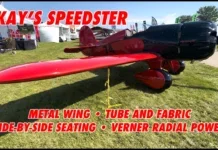Homebuilders with a penchant for light, simple, inexpensive airplanes have been watching Sonex Aircraft develop the High Wing model for a couple of years now. Company owner Mark Schaible joins us to talk about the airplane’s gestation and expectations for performance and when it might fly. Hint: You’ll be able to see a cabin mockup at AirVenture this year at the least.
In general, Sonex is hoping for performance similar to the low-wing Sonex designs and will be building the first example as a taildragger with a 130-hp ULPower engine. Schaible also discusses changes to the design now that MOSAIC is closer to reality. Expanded Sport Pilot rules could allow Sonex to give the High Wing a gross weight above the current 1320-pound maximum for LSA.














Electric homebuilt aircraft are the future. Battery improvements are coming at astonishing speed.
Please dedicate more resources to electric planes
Charging times for the newest batteries have fallen to 15 minutes or less in formula e racing they are very close to being able to charge during a pit stop.
This means that if charging infrastructure is put in at airports cross country use of electric plabes is already viable. Electric planes will be very cheap to operate and will be significantly safer
Most EV cars are prohibitively expensive compared to their ICE alternatives. That cost increase will impact aircraft as well, and even more so due to the weight restrictions airplanes have to deal with. EV cars are much heavier than their ICE equivalents if they have sufficient range. Such impacts on cost and reduction in performance makes EV aircraft less viable and less accessible to more people. Most people will still opt for ICE aircraft due to the cost and performance loss (range and useful payload are aspects of performance).
Most EV planes currently existing are so short range that I couldn’t even fly to my next closest airport and back without running out of charge. The highest theoretical battery energy density known today (that I’m aware of) is Aluminum-Air batteries, and they are not rechargeable. And even Aluminum Air batteries aren’t energy dense enough to truly make EV airplanes viable.
Rolls Royce sold their electric flight business unit and gave up on developing electric airplanes. Let’s have realistic expectations, and not make the mistake of ignoring basic physics in favor of claims that only exist in fantasy. And let’s not ignore the safety implications either.